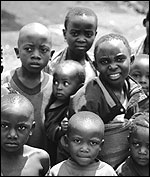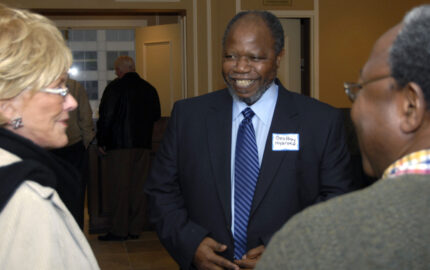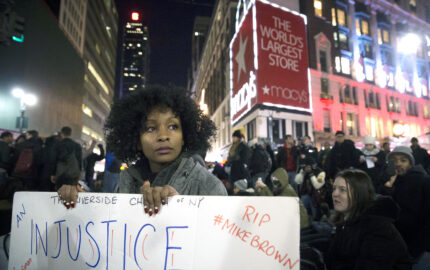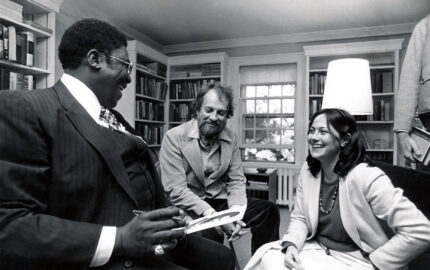The Congolese doctor ushered us into the small hospital room—the labor and delivery room, he told us. There, lying on a bed, was a woman who had just given birth to a stillborn baby. We stared briefly at her before shame overtook us, and we looked away. How could we invade her privacy at this moment—for her surely one of anguish and pain?
Moments later, the doctor walked over to a corner of a room, to an antiquated infant weighing scale standing on a table. Atop the scale was what appeared to be a pile of colorful African cloth. The doctor slowly unwrapped it and, inside, we saw a newborn baby. Its stomach and intestines were clearly visible, bulging out through the infant’s navel and lying outside its body—a condition called omphalocele. In the United States, the condition would be treated surgically, and the infant would probably go on to live a full and healthy life. Here in Eastern Congo, in a hamlet two hours over unpaved road from the nearest small city, the baby probably had just days, if not hours, to live.
These scenes, from a recent trip I took to the Democratic Republic of the Congo, are seared into my memory. I traveled there for the International Rescue Committee (IRC), a New York-based humanitarian relief organization on whose board of directors I serve. The IRC operates relief programs for refugees and displaced persons in 24 countries around the world. A group of us from the board who oversee the organization’s health-related relief efforts had gone to the field to observe IRC’s operations in war-torn Congo, the very definition of a fragile state.
If there’s a hall of fame for countries that have been victims of the world’s greatest injustices, Congo surely has a place of prominence. In the 19th and early 20th centuries, the systematic looting and exploitation of the area by King Leopold II of Belgium resulted in the deaths of more than three million people. Following independence in 1960 came the three-decade reign of Mobutu Sese Seko, who renamed the country Zaire. It is hard to comprehend how thoroughly Mobutu looted this mineral-rich nation while simultaneously underinvesting in almost anything that could benefit his people. Even today this country, roughly the size of the United States east of the Mississippi, has fewer than 500 miles of paved roads.
In the late 1990’s and early 2000’s, Congo was embroiled in an eight-nation conflict that finally ended with a treaty in 2003. Democratic elections in 2006 put a president in power in Kinshasa, the capital, who even today confronts fighting among forces representing the government and rebel groups in the east. It’s no stretch to say that Congo is a tinderbox from which conflict could spread to much of central and east Africa. And according to a major series of surveys carried out by IRC, nearly four million more Congolese died than might have been expected between 1998 and 2004 due to an imploded national health system and the inability to stop even preventable diseases, such as measles. Shockingly, about half of those overall deaths have been in children under age five.
In my professional life, as health correspondent for “The NewsHour with Jim Lehrer” on PBS, my feet are firmly planted in what I call the “Health Care World of Plenty.” I mainly cover the U.S. healthcare system—that $2 trillion-plus behemoth of high technology and innovation and, as we increasingly know, startling inefficiency, ineffectiveness and just plain old waste. In the work I do for IRC, I have a foot in the “Health Care World of Want.” The contrasts are devastating and painful, but the knowledge of one has informed my coverage of the other. I am a better journalist, and a better person, for having feet in both camps.
For all the woes of U.S. health care—and they are legion—I have learned a far greater respect for what we do have. Our superior advantage in knowledge, skill and technology of health care is self-evident. I increasingly also understand how our advantages in these areas have raised the value we place on life—or, at least, on many lives lived here in America. At one end of the lifespan, we would think nothing of spending thousands of dollars to operate on a baby born in the United States with omphalocele—just as we spend hundreds of thousands of dollars to save the lives of even one premature infant. At the other end of life’s spectrum, new cancer drugs are deemed successful and worth paying tens of thousands of dollars for, if they extend the lives of patients with metastatic cancer by just several months. In this sense, we’re indisputably pro-life in our national health policy, willing to spend just about anything to extend the lives of millions of our citizens—provided, of course, that they are among those fortunate enough to have health insurance.
The value we assign to our lives is also evident in other ways, like privacy. In a modern U.S. hospital, it’s highly unlikely a doctor would ever have ushered me into a room of a woman who’d just given birth to a stillborn. It certainly would never happen without asking the woman’s permission. Most likely she’d be asked to sign a document indicating that she had given her permission under a federal law known as HIPAA for her identity and condition to be disclosed. These federal privacy protections for patients have sometimes been the bane of my existence as a journalist; for example, after Hurricane Katrina, our TV crew was denied access to evacuees from New Orleans in a makeshift hospital in Baton Rouge on the ground that we’d be violating the patients’ privacy. But when we walked in on the grieving woman in Congo, I couldn’t help but think what a societal advance the respect for the guarantee of privacy in health care settings represents.
Developing an appreciation for what we have in the United States is the upside of having a foot in both worlds. There is also a substantial downside. Mostly this stems from coming to grips with the industrialized world’s indifference to Africa and the pain of coming to understand intimately the suffering of others in poor parts of the globe.
How could an estimated four million people have died in Congo from 1998 to 2004, with the world paying so little attention to the scope of this humanitarian disaster? How is it that this high death rate is still tolerated, amid ongoing signs that the trend hasn’t abated? Why is it that the world can focus its attention on some global crises, like Darfur, but not on others—particularly when, as in Congo, the violence happens over time through neglect? How is it that aid delivered to tsunami-affected areas in South and Southeast Asia in 2005 exceeded by 100 times the per-person amount of international assistance that went to Congo that same year?
As a journalist, I now know the humanitarian disaster in Congo is among the past decade’s most underreported major stories. I may never have encountered it myself but for my work with IRC. For all the stories I can tell here in the United States about the Health Care World of Plenty, I now understand how many more compelling ones exist in the Health Care World of Want. And over the remaining years of my career in journalism, I’m determined to figure out a way to tell them.
Susan Dentzer, a 1987 Nieman Fellow, is health correspondent for “The NewsHour with Jim Lehrer” on PBS. She also serves on the boards of directors of the International Rescue Committee and the Global Health Council.
Moments later, the doctor walked over to a corner of a room, to an antiquated infant weighing scale standing on a table. Atop the scale was what appeared to be a pile of colorful African cloth. The doctor slowly unwrapped it and, inside, we saw a newborn baby. Its stomach and intestines were clearly visible, bulging out through the infant’s navel and lying outside its body—a condition called omphalocele. In the United States, the condition would be treated surgically, and the infant would probably go on to live a full and healthy life. Here in Eastern Congo, in a hamlet two hours over unpaved road from the nearest small city, the baby probably had just days, if not hours, to live.
These scenes, from a recent trip I took to the Democratic Republic of the Congo, are seared into my memory. I traveled there for the International Rescue Committee (IRC), a New York-based humanitarian relief organization on whose board of directors I serve. The IRC operates relief programs for refugees and displaced persons in 24 countries around the world. A group of us from the board who oversee the organization’s health-related relief efforts had gone to the field to observe IRC’s operations in war-torn Congo, the very definition of a fragile state.
If there’s a hall of fame for countries that have been victims of the world’s greatest injustices, Congo surely has a place of prominence. In the 19th and early 20th centuries, the systematic looting and exploitation of the area by King Leopold II of Belgium resulted in the deaths of more than three million people. Following independence in 1960 came the three-decade reign of Mobutu Sese Seko, who renamed the country Zaire. It is hard to comprehend how thoroughly Mobutu looted this mineral-rich nation while simultaneously underinvesting in almost anything that could benefit his people. Even today this country, roughly the size of the United States east of the Mississippi, has fewer than 500 miles of paved roads.
In the late 1990’s and early 2000’s, Congo was embroiled in an eight-nation conflict that finally ended with a treaty in 2003. Democratic elections in 2006 put a president in power in Kinshasa, the capital, who even today confronts fighting among forces representing the government and rebel groups in the east. It’s no stretch to say that Congo is a tinderbox from which conflict could spread to much of central and east Africa. And according to a major series of surveys carried out by IRC, nearly four million more Congolese died than might have been expected between 1998 and 2004 due to an imploded national health system and the inability to stop even preventable diseases, such as measles. Shockingly, about half of those overall deaths have been in children under age five.
In my professional life, as health correspondent for “The NewsHour with Jim Lehrer” on PBS, my feet are firmly planted in what I call the “Health Care World of Plenty.” I mainly cover the U.S. healthcare system—that $2 trillion-plus behemoth of high technology and innovation and, as we increasingly know, startling inefficiency, ineffectiveness and just plain old waste. In the work I do for IRC, I have a foot in the “Health Care World of Want.” The contrasts are devastating and painful, but the knowledge of one has informed my coverage of the other. I am a better journalist, and a better person, for having feet in both camps.
For all the woes of U.S. health care—and they are legion—I have learned a far greater respect for what we do have. Our superior advantage in knowledge, skill and technology of health care is self-evident. I increasingly also understand how our advantages in these areas have raised the value we place on life—or, at least, on many lives lived here in America. At one end of the lifespan, we would think nothing of spending thousands of dollars to operate on a baby born in the United States with omphalocele—just as we spend hundreds of thousands of dollars to save the lives of even one premature infant. At the other end of life’s spectrum, new cancer drugs are deemed successful and worth paying tens of thousands of dollars for, if they extend the lives of patients with metastatic cancer by just several months. In this sense, we’re indisputably pro-life in our national health policy, willing to spend just about anything to extend the lives of millions of our citizens—provided, of course, that they are among those fortunate enough to have health insurance.
The value we assign to our lives is also evident in other ways, like privacy. In a modern U.S. hospital, it’s highly unlikely a doctor would ever have ushered me into a room of a woman who’d just given birth to a stillborn. It certainly would never happen without asking the woman’s permission. Most likely she’d be asked to sign a document indicating that she had given her permission under a federal law known as HIPAA for her identity and condition to be disclosed. These federal privacy protections for patients have sometimes been the bane of my existence as a journalist; for example, after Hurricane Katrina, our TV crew was denied access to evacuees from New Orleans in a makeshift hospital in Baton Rouge on the ground that we’d be violating the patients’ privacy. But when we walked in on the grieving woman in Congo, I couldn’t help but think what a societal advance the respect for the guarantee of privacy in health care settings represents.
Developing an appreciation for what we have in the United States is the upside of having a foot in both worlds. There is also a substantial downside. Mostly this stems from coming to grips with the industrialized world’s indifference to Africa and the pain of coming to understand intimately the suffering of others in poor parts of the globe.
How could an estimated four million people have died in Congo from 1998 to 2004, with the world paying so little attention to the scope of this humanitarian disaster? How is it that this high death rate is still tolerated, amid ongoing signs that the trend hasn’t abated? Why is it that the world can focus its attention on some global crises, like Darfur, but not on others—particularly when, as in Congo, the violence happens over time through neglect? How is it that aid delivered to tsunami-affected areas in South and Southeast Asia in 2005 exceeded by 100 times the per-person amount of international assistance that went to Congo that same year?
As a journalist, I now know the humanitarian disaster in Congo is among the past decade’s most underreported major stories. I may never have encountered it myself but for my work with IRC. For all the stories I can tell here in the United States about the Health Care World of Plenty, I now understand how many more compelling ones exist in the Health Care World of Want. And over the remaining years of my career in journalism, I’m determined to figure out a way to tell them.
Susan Dentzer, a 1987 Nieman Fellow, is health correspondent for “The NewsHour with Jim Lehrer” on PBS. She also serves on the boards of directors of the International Rescue Committee and the Global Health Council.




